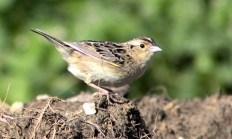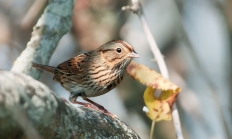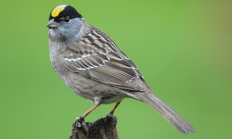Search myodfw.com
The California towhee can be found in chaparral habitats of southern Oregon, quietly flitting in and out of the brush in search of seeds. It is a plain brown bird with a rusty throat patch and undertail coverts. It is noticeably larger than the Spotted towhee. Its long slender tail is also a useful identifying feature. Sexes cannot be told apart in the field, but juveniles can be distinguished by the extensive streaking and spotting of the underparts. The California towhee is a fairly common permanent resident throughout the Rogue, Applegate, and Illinois Valleys. Hear the song of the California

This winter visitor is a study in gray and tan, with a small dark spot on an otherwise gray breast, dull rufous stripes on the side of the head and crown, and brown wings with distinct white stripes. Tree sparrows visit Oregon only in winter, mainly in lowlands within the Blue Mountains and Owyhee upland regions with a few farther west in some years. They frequent willow clumps in grassy areas and occur occasionally at feeders. Hear the song of the American tree sparrow Photo by Eric Began, Flickr

The Chipping sparrow is a small and slender sparrow that has a distinctive sharp chip note and simple, trilling song. Breeding adults display a chestnut crown, a black eye-stripe, and crisp white eyebrow. After nesting season, both male and female lose their distinctive bright cap for a streaky dull brown head pattern that is similar to other winter sparrows. It is a common summer resident in open forests and drier woodland edges throughout Oregon and is especially abundant in the Blue Mountains. The Chipping sparrow is an Oregon Conservation Strategy Species in the Willamette Valley ecoregion. Hear the song of

The song of this bird is one of the characteristic sounds of spring evenings in much of the high desert country of eastern Oregon. This temperate migrant is a ground-nesting, ground-foraging bird of most of the grassland, agricultural land, and shrubs steppe habitats of Oregon. The streaked brownish plumage of the Vesper sparrow is similar to that of several small to medium-sized sparrows, except for white outer tail feathers, shown most conspicuously in flight. The Oregon vesper sparrow is an Oregon Conservation Strategy Species in the Klamath Mountains and Willamette Valley ecoregions. Hear the song of the Vesper sparrow Photo

The adult Lark sparrow is one of the most easily recognized passerines. The head pattern is sharp and crisp, with a chestnut crown and cheek patch surrounded by alternating white and black stripes. White underparts with a a small black central spot and a long, blackish tail with conspicuous white wing corners further aid identification. Courtship behaviors, including turkey-like strutting by males, differ markedly from that of other passerines. In Oregon, the Lark sparrow is a locally common summer resident and migrant east of the Cascades. Hear the song of the Lark sparrow Photo by Beken Bulgic Schneider, Flickr

This uncommon inhabitant of Oregon's high desert can be a challenge to find unless the observer becomes familiar with its territorial song and preferred habitat. Habitat requirements are specialized and population distribution and densities are highly variable from year to year in Oregon. The Black-throated sparrow occurs along boulder-strewn, sparsely vegetated slopes of arid deserts. They prefer warm dry sunny slopes of desert basins. Hear the song of the Black-throated sparrow Photo by Ashley Tubbs, Flickr

Although common within its range, this handsome sparrow can easily be overlooked. The gray head, black malar stripe, white eyebrow, and prominent black spot set in the middle of a white breast identify the bird. It is widespread throughout the extensive shrub-steppe of central and eastern Oregon. The principal breeding range of Sagebursh sparrow is southeast and central Oregon. It is found throughout the arid expanses of the Great Basin and usually associated with big sage. Although considered by some authors to be a sagebrush obligate, Sagebrush sparrows have been found in other plant communities exclusive of sagebrush. Hear the

The buzzy, insect-like song of the Savannah sparrow is a characteristic sound of open landscapes dominated by grasslands throughout Oregon. Savannah sparrows are usually heard or seen when perched atop a fence post, small shrub, or tall weed, or running on the ground between openings in vegetation until the bird abruptly drops down into cover. The Savannah sparrow nests on the ground, often in a slight depression and well concealed by a canopy of dead vegetation or partially tucked under a clump of vegetation. Hear the song of the Savannah sparrow Photo by Dave Budeau, ODFW

The Grasshopper sparrow is one of the more enigmatic and erratic birds in Oregon. A small population may appear in an area, persist for a few years, and then disappear, only to return at some later time. It is difficult to detect, because of both its quiet, insect-like song and its reclusive habits. Males sing from elevated perches, such as flower stalks or fence posts before diving back among the grasses. It occurs in scattered "colonies" along the unforested northern slopes of the Blue Mountains. The Grasshopper sparrow is an Oregon Conservation Strategy Species in the Columbia Plateau, Klamath Mountains

Although not brilliantly plumaged, the conspicuous Song Sparrow is one of the more regularly seen birds in Oregon. Defensive and curious, when approached it readily announces its presence with loud chips and often excitedly rises to a conspicuous perch to confront the interloper. The Song sparrow is well named as both male and female have a variety of songs that may be heard at any time of year, and juvenile birds begin to sing full songs within two months of hatching. The Song sparrow is a common and widespread resident of western Oregon. Hear the song of the Song sparrow

This small tan-and-gray sparrow with a delicately streaked upper breast is found in summer in wet mountain meadows where its bubbly song can be heard from low shrubs. It winters in brushy lowland areas where it skulks in tall grass and weeds and is usually seen for only a moment. It breeds locally above 3,000 feet in the west Cascades and winters in the valleys west of the cascades. Hear the song of the Lincoln's sparrow Photo by Kelly Colgan-Azar, Flickr

The Swamp sparrow uses wet areas that have thick vegetation for cover. Several glimpses of this reclusive bird may be required before it can safely be separated from Lincoln's sparrow or the more common Song sparrow, though its distinctive call will give it away to observers familiar with it. Chestnut coloration on the wing coverts helps separate this species from other wintering sparrows. The Swamp swallow is a rare to uncommon spring and fall transient and winter visitant in western Oregon, especially along the coast. Hear the song of the Swamp sparrow Photo from USFWS

Flocks of these big, brown, plain sparrows are a common sight in winter in western Oregon. By early spring their faded head markings become a beautiful gold, black and white, and their plaintive descending songs become frequently heard from almost any large brush pile. They are an abundant migrant in western Oregon, less common farther east, and abundant in winter throughout the Willamette Valley. Hear the song of the Golden-crowned sparrow Photo by Dave Budeau, ODFW

Within wintering flocks of Horned Larks in the valleys of eastern Oregon, and along flats bordering coastal estuaries in the fall, it is sometimes possible to find flocks of this large arctic-breeding sparrow. Their habit of running along the ground in a crouch rather than flying makes them a challenge to observe, but in flight their characteristic rattling call is unmistakable. Otherwise, in fall and winter plumage, they appear as brownish streaked sparrows. In flight their dark tail with white sides is conspicuous. Along the outer Oregon coast, the Lapland longspur is an uncommon but regular fall migrant, especially at

This species breeds from northeast British Columbia to Nova Scotia and south to north Georgia. It winters in Middle and South America. Small numbers regularly occur along the west coast, especially in spring. The majority of Oregon records have occurred from early March through July, mostly from mid-May to mid-June. Individuals are occasionally found from mid-September to mid-January, mostly birds that remained less than five days. Here the song of the Rose-breasted grosbeak Photo by Anna Hesser, Flickr

All of Oregon's blue-colored birds are appreciated for their dazzling appearance, but the striking plumage of this summer visitor is accompanied by a song described as vivacious, varied, well-articulated and sweet. Males are unmistakable when singing from a prominent perch, flashing deep azure upper parts with rich orange-brown breast and flanks, a white belly, and white wing bars. Females are warm brown and relatively plain, though they share with males the habit of twitching the tail to one side when excited. The Lazuli bunting is fairly common in low-elevation dry valleys in Curry County but are becoming uncommon north through

Observers can see mixed flocks of Oregon's four species of blackbirds, the Great-tailed grackle and the Brown-headed cowbird.

The male Red-winged blackbird, sentry of the marsh during the breeding season, continually announces its territory to all present with its oak-a-tee song, and tenaciously defends against flyby predators. The male is territorial, polygynous, larger than the female, and glossy black with a broad bar of red-orange, bordered with yellow, on wing writs. Females are less conspicuous in behavior, light brown, with a heavily streaked breast, and buffy supercilium. This is one of the most abundant and studied birds in North America. The Red-winged blackbird occurs west of the Cascades in Oregon from coastal and valley locations, and east of

The gregarious Tricolored blackbird is one of North America's most intensely colonial breeders, forming dense, non-territorial, noisy colonies. A highly synchronized nesting system exploits secure nesting locations and rich food supplies that change from year to year. In Oregon, breeding colonies are scattered and intermittent at specific locations, though sites used during consecutive years may be in the same general area. The Tricolored blackbird breeds most consistently in Klamath and Jackson Counties. Small colonies and summering residents have been found in the Willamette Valley; during fall and winter they are rare. Most retreat south to California in winter, while some

The song of the Yellow-headed blackbird, if it can be called a song as it lacks any musical quality, is a familiar sound in the marshes particularly of central and southeastern Oregon. The male, with its yellow head, neck, and breast, black body and wings, and white wig patches, is unmistakable. The female is more subtle with its dusky or sooty brown body plumage and yellow cheeks, chin, throat and chest, but is also distinctive. It is an abundant spring and summer resident in marshes of large alkaline lakes and wetlands in southeast Oregon, most notably the Klamath, Summer, Malheur

